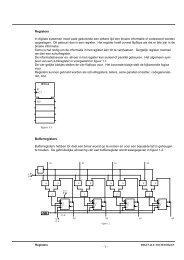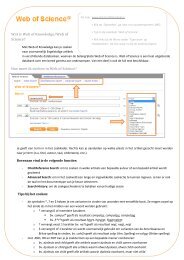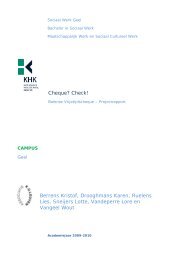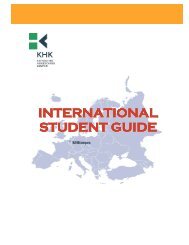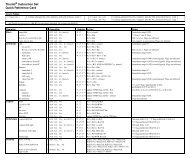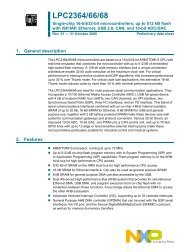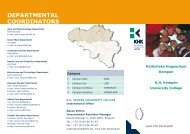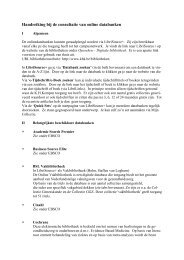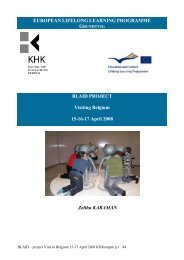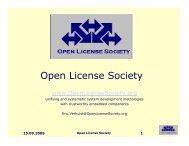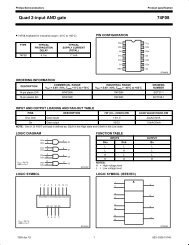Learning a Transfer Function for Reinforcement Learning ... - Lirias
Learning a Transfer Function for Reinforcement Learning ... - Lirias
Learning a Transfer Function for Reinforcement Learning ... - Lirias
You also want an ePaper? Increase the reach of your titles
YUMPU automatically turns print PDFs into web optimized ePapers that Google loves.
<strong>Learning</strong> a <strong>Transfer</strong> <strong>Function</strong> <strong>for</strong> Rein<strong>for</strong>cement <strong>Learning</strong> Problems<br />
Tom Croonenborghs 1 , Kurt Driessens 2 and Maurice Bruynooghe 2<br />
1: Biosciences and Technology Department, KH Kempen University College, Geel, Belgium<br />
2: Declarative Languages and Artificial Intelligence Group, Katholieke Universiteit Leuven (KUL), Belgium<br />
tom.croonenborghs@khk.be<br />
{kurt.driessens,maurice.bruynooghe}@cs.kuleuven.be<br />
Abstract<br />
The goal of transfer learning algorithms is to utilize<br />
knowledge gained in a source task to speed up learning<br />
in a different but related target task. Recently, several<br />
transfer methods <strong>for</strong> rein<strong>for</strong>cement learning have been<br />
proposed. A lot of them require a mapping that relates<br />
features from the source task to those of the target task,<br />
and most of the time it is the task of a domain expert to<br />
hand code these mappings.<br />
This paper proposes a method to learn such a mapping<br />
automatically from interactions with the environment,<br />
using a probability tree to represent the probability that<br />
the optimal action learned in the source task is useful<br />
in the target task. Preliminary experiments show that<br />
our approach can learn a meaningful mapping that can<br />
be used to speed up learning through the execution of<br />
transferred actions during exploration.<br />
Introduction<br />
Inductive transfer or transfer learning is concerned with the<br />
connection between learning in different but related contexts.<br />
In real life, the beneficial effects of transfer learning<br />
are obvious. Examples include learning to drive a bus after<br />
having learned to drive a car or learning Dutch after having<br />
learned German (except of course <strong>for</strong> native Dutch speaking<br />
people). In a machine learning context, transfer learning is<br />
concerned with the added benefits that learning one task can<br />
have on a different, but probably related task.<br />
An area where transfer learning is particularly important<br />
is the domain of Rein<strong>for</strong>cement <strong>Learning</strong>. In rein<strong>for</strong>cement<br />
learning (Sutton & Barto 1998), an agent can observe its<br />
world and per<strong>for</strong>m actions in it. The agent’s learning task<br />
is to maximize the reward he obtains. Rein<strong>for</strong>cement learning<br />
is often approached as a tabula rasa learning technique,<br />
where at the start of the learning task, the agent has no or<br />
little in<strong>for</strong>mation and is <strong>for</strong>ced to per<strong>for</strong>m random exploration.<br />
As a consequence, rein<strong>for</strong>cement learning in complex<br />
domains quickly becomes infeasible or too slow in<br />
practice. Leveraging knowledge could significantly increase<br />
the learning speed and thereby expand the applicability of<br />
rein<strong>for</strong>cement learning approaches.<br />
Copyright c○ 2008, Association <strong>for</strong> the Advancement of Artificial<br />
Intelligence (www.aaai.org). All rights reserved.<br />
Recently, several approaches have been proposed to transfer<br />
knowledge between different rein<strong>for</strong>cement learning<br />
tasks. Often, a user defined mapping is used to relate the new<br />
task to the task <strong>for</strong> which a policy was already learned (Taylor,<br />
Whiteson, & Stone 2007; Torrey et al. 2006). There has<br />
been some work on learning such a mapping. For example,<br />
in the work by Liu and Stone (Liu & Stone 2006) a graphmatching<br />
algorithm is used to find similarities between state<br />
variables in the source and target task. This approach however<br />
needs a complete and correct transition model <strong>for</strong> both<br />
tasks. A similar approach is used by (Kuhlmann & Stone<br />
2007) in the context of General Game Playing.<br />
In this paper, transfer learning is achieved by considering<br />
transfer actions, i.e. actions transferred from the source task<br />
to the target task during the exploration phase of the learning.<br />
To decide which action to transfer, the agent learns a<br />
function that predicts <strong>for</strong> each source action the probability<br />
that executing the transfered action is at least as good as<br />
executing the action which is best according to the agent’s<br />
current utility function and selects the one with the highest<br />
probability.<br />
The rest of the paper is structured as follows: the next<br />
section introduces the notion of transfer during exploration<br />
and the transfer function. It also describes how the transfer<br />
function can be learned from simple interaction with the environment<br />
without the need <strong>for</strong> an external oracle to define<br />
a feature mapping. Afterwards we present some preliminary<br />
experiments that serve as a proof of concept. We review<br />
some related work and directions <strong>for</strong> future work at the end<br />
of the paper.<br />
Using Exploration to <strong>Transfer</strong> Knowledge<br />
We consider a standard rein<strong>for</strong>cement learning problem<br />
(Sutton & Barto 1998) where an agent interacts with its environment.<br />
The environment is defined by a set of states<br />
s ∈ S, a number of executable actions a ∈ A, an unknown<br />
state-transition function δ(s, a, s ′ ) : S × A × S → [0, 1]<br />
that represent the probability that taking action a in state<br />
s will result in a transition to state s ′ and a reward function<br />
r(s, a) : S × A → IR. When the reward function<br />
is nondeterministic, we will use the expected rewards<br />
R(s, a) = E s,a [r(s, a)]. The state, action, and reward at<br />
time t are denoted s t ∈ S, a t ∈ A and r t (or R t ) ∈ IR.<br />
The agent selects which action to execute in a state fol-
lowing a policy function π(s) : S → A. During exploration<br />
of the environment the agent uses an exploration strategy indicated<br />
by π e that guarantees that each state-action combination<br />
has a non-zero probability of being visited. The utility<br />
of a state-action pair Q π (s, a) <strong>for</strong> a policy π is defined as<br />
the expected discounted sum of future reward, starting from<br />
state s by selecting action a and following the actions indicated<br />
by policy π afterwards:<br />
[ ∞<br />
]<br />
∑<br />
Q π (s, a) = E π,δ,r γ i R t+i |s t = s, a t = a (1)<br />
i=0<br />
where γ ∈ [0, 1[ is the discount factor.<br />
<strong>Transfer</strong> Actions<br />
To incorporate knowledge transfer into the exploration of<br />
the rein<strong>for</strong>cement learning agent, the standard exploration<br />
policy π e of the agent is altered. In our initial ef<strong>for</strong>ts, we<br />
decided to emulate ɛ-based exploration to accomplish this<br />
integration. With a given probability of ɛ t the agent will<br />
select and execute a transfer action π t (s) instead of the normal<br />
exploration action π e (s). In lieu of the learning speedup<br />
obtained with guidance from experts in complex rein<strong>for</strong>cement<br />
learning tasks (Driessens & Dzeroski 2004), we expect<br />
these transfer actions to help with learning, under the condition<br />
that the transfer actions are chosen appropriately.<br />
Assume the agent has learned a policy π s that per<strong>for</strong>ms<br />
well on the source task. To decide which transfer action to<br />
per<strong>for</strong>m in a state t of the target problem, we will employ a<br />
transfer function p(s, t) that represents <strong>for</strong> each source state<br />
s the probability that the best action <strong>for</strong> s is at least as good<br />
<strong>for</strong> t as the best action according to the current approximation<br />
of the utility function. This function allows the agent<br />
to select a transfer action according to the policy learned on<br />
the source task, <strong>for</strong> that state s from the source task that<br />
maps best onto the target state t. Thus, the transfer action<br />
per<strong>for</strong>med in state t (i.e., π t (t)) is the action per<strong>for</strong>med by<br />
policy π s in the state s <strong>for</strong> which p(s, t) is maximal, i.e.,<br />
π t (t) = π s (argmax p(s, t)) (2)<br />
s<br />
with π s the source task policy.<br />
Note that we assume <strong>for</strong> simplicity that actions in the<br />
source task are executable in the target task. In the current<br />
setup, if this is not the case, we could generate a negative<br />
reward when the agent tries to execute a non-available action,<br />
and it would quickly learn that the transfer function<br />
<strong>for</strong> the state that suggested this action should be low. In future<br />
work, we will extend our approach so that the transfer<br />
function maps (state,action)-pairs and is thereby able to incorporate<br />
the relation between actions.<br />
Algorithm 1 <strong>Transfer</strong> <strong>Learning</strong> by Exploration<br />
1: initialize the Q-function hypothesis ˆQ 0<br />
2: initialize the transfer function ˆP 0<br />
3: e ← 0<br />
4: repeat {<strong>for</strong> each episode}<br />
5: Ex Q ← ∅<br />
6: Ex P ← ∅<br />
7: generate a starting state s 0<br />
8: i ← 0<br />
9: repeat {<strong>for</strong> each step of episode}<br />
10: if rand() < ɛ t then {select transfer action}<br />
11: a i = π s (argmax<br />
t<br />
p(t, s))<br />
12: t i = argmax<br />
t<br />
13: else {select exploration action}<br />
14: a i = a with prob.<br />
e<br />
p(t, s) {remember transfer state}<br />
ˆQe(s,a)<br />
τ<br />
Pb≠a e Qe(s,b)<br />
τ<br />
15: end if<br />
16: take action a i , observe r i and s i+1<br />
17: i ← i + 1<br />
18: until s i is terminal<br />
19: q i−1 ← r i−1<br />
20: <strong>for</strong> j = i − 2 to 0 do<br />
21: q j ← r j + γq j+1<br />
22: generate example x q = (s j , a j , q j )<br />
23: Ex Q ← Ex Q ∪ {x q }<br />
24: if a was selected as transfer action, i.e.<br />
a j = π s (argmax t p(t, s j )) then<br />
25: if q j ≥ max a ˆQe (s j , a) then<br />
26: generate example x p = (t j , s j , ‘transfer’)<br />
27: else<br />
28: generate example x p = (t j , s j , ‘no transfer’)<br />
29: end if<br />
30: Ex P ← Ex P ∪ {x p }<br />
31: end if<br />
32: end <strong>for</strong><br />
33: Update ˆQ e using Ex Q to produce ˆQ e+1<br />
34: Update ˆP e using Ex P to produce ˆP e+1<br />
35: e ← e + 1<br />
36: until no more episodes<br />
<strong>Learning</strong> the <strong>Transfer</strong> <strong>Function</strong><br />
The aim of this work is to avoid the need <strong>for</strong> a human expert<br />
that defines a mapping function between the source and the<br />
target task, but to be able to learn this mapping automatically.<br />
In the setup described above, this means we have to<br />
learn the transfer function p(s, t) : S s × S t → [0, 1], where<br />
S S is the set of states of the source task and S t is the set of
states from the target task, from interaction with the environment.<br />
At the end of every learning episode in the target task,<br />
a number of learning examples <strong>for</strong> the transfer function can<br />
be generated. For every transfer action a t the agent executed<br />
(in a state s) during the episode, he can compare the quality<br />
of the transfer action with the quality of his current policy<br />
using two different utility values. On the one hand, a Q-<br />
value Q MC (s, a t ) can be obtained by backtracking the Q-<br />
values from the end of that episode to the step where a t is<br />
executed. This is comparable to a Monte Carlo estimate of<br />
this Q-value. On the other hand we let the agent learn a Q-<br />
value approximation ˆQ of its current policy using a standard<br />
Q-learning type algorithm with generalization.<br />
The generated learning example <strong>for</strong> each executed transfer<br />
action then consists of the states in both the source and<br />
target task and a label <strong>for</strong> the example:<br />
“transfer” if Q MC (s, a t ) ≥ max a ˆQ(s, a) and<br />
“no transfer” otherwise<br />
Using a learning algorithm able to predict class probabilities,<br />
the learning agent can generate a generalized probability<br />
function that approximates the intended transfer function<br />
p by predicting the probability that a new state-state pair will<br />
belong to the class “transfer”.<br />
Note that, in practice, we are not interested in the exact<br />
probability value as defined by the function p. The purpose<br />
of p is to generate a positive effect of the transferred actions<br />
on the learning speed.<br />
An overview of the rein<strong>for</strong>cement learning algorithm with<br />
transfer by exploration can be found in Algorithm 1. Note<br />
that we used a SARSA temporal difference learner (Rummery<br />
& Niranjan 1994) (line 21), but another rein<strong>for</strong>cement<br />
learning technique could be used instead.<br />
Preliminary Experiments<br />
We implemented a prototype of the suggested approach to<br />
act as a proof of principle. We decided to use a first order<br />
tree learning algorithm TILDE (Blockeel & De Raedt<br />
1998) to learn the transfer function p. The TILDE system<br />
is able to predict class probabilities as required in our setup<br />
(Fierens et al. 2005). To approximate the utility values,<br />
we use the SARSA temporal difference approach (Sutton &<br />
Barto 1998) and an incremental regression tree algorithm<br />
TG (Driessens, Ramon, & Blockeel 2001) to generalise the<br />
utility function. These choices are not specific to the approach,<br />
only to our current implementation.<br />
Experimental Setup<br />
To evaluate our implementation, we ran experiments in a<br />
simple grid based world, depicted in Figure 1. The rooms<br />
are connected with colored doors which the agent (indicated<br />
with the diamond labelled “a”) can only pass if he possesses<br />
a key of the same color as the door (depicted with colored<br />
circles). The primitive actions available to the agent include<br />
four movement actions (up, down, left and right) and<br />
a pickup action that picks up the key located at the agent’s<br />
location (if applicable). The agent can execute at most 500<br />
a<br />
(1,1) (1,2) (1,3) (1,4)<br />
(2,1) (2,2) (2,3) (1,2)<br />
(3,1) (3,2) (3,3) (1,3)<br />
(4,1) (4,2) (4,3) (4,4)<br />
(5,5) (5,6) (5,7) (5,8)<br />
(6,5) (6,6) (6,7) (6,8)<br />
(7,5) (7,6) (7,7) (7,8)<br />
(8,5) (8,6) (8,7) (8,8)<br />
Figure 1: Grid based world.<br />
(9,9) (9,10) (9,11) (9,12)<br />
(10,9) (10,10) (10,11) (10,12)<br />
(11,9) (11,10) (11,11) (11,12)<br />
(12,9) (12,10) (12,11) (12,12)<br />
actions per episode and receives a reward of 1 if he exits the<br />
last room and 0 otherwise. The state representation includes<br />
the dimensions of the different rooms, the locations and colors<br />
of the doors, the location and colors of the keys, the keys<br />
the agent possesses, the agent’s location and the goal location.<br />
The location consists of two coordinates where a coordinate<br />
is determined by the relative position in the room and<br />
a certain offset <strong>for</strong> every room as indicated in Figure 1.<br />
In the source task, the agent had (successfully) learned<br />
how to navigate to the bottom right location in a four by<br />
four grid.<br />
Results<br />
As a first experiment, instead of continuously learning the<br />
transfer function, we learned a single transfer function once<br />
with TILDE (Blockeel & De Raedt 1998) based on learning<br />
examples created during the first 100 learning episodes in<br />
the target task and actions transferred from random source<br />
states. The algorithm was able to learn both the shift in<br />
coordinates between the different rooms and that successful<br />
transfer is very unlikely if the agent does not have the<br />
key needed to leave the current room. We then restarted the<br />
agent in the environment with the learned transfer function.<br />
Figure 2 shows the average reward and Figure 3 the number<br />
of actions per episode of a SARSA-learning agent, both<br />
with and without transfer. The numbers are obtained by<br />
freezing the current utility function and following a greedy<br />
test policy <strong>for</strong> 100 episodes every 50 episodes. We show<br />
results averaged over 10 runs.<br />
Discussion<br />
As shown, the approach with transfer reaches the goal state<br />
in a higher percentage of trials and uses less actions per<br />
episode to reach it. The graph does not show the 100 learning<br />
episodes used to generate the learning examples to learn<br />
the transfer function which is an added cost in our current<br />
implementation and should be taken into account when interpreting<br />
the learning speed. In future work, we would like<br />
to employ an online, incremental learning algorithm to learn<br />
the transfer function and to eliminate this extra cost.<br />
Related Work<br />
A lot of transfer learning approaches use a mapping to relate<br />
the new task to the task <strong>for</strong> which a policy was already<br />
learned. This mapping relates features from the old task to
Figure 2: Average reward with and without transfer function.<br />
Figure 3: Average number of actions with and without transfer<br />
function.<br />
features from the new task. How this mapping is then used<br />
to transfer knowledge differs between approaches. Quite often,<br />
the previously learned policy is used to guide exploration<br />
in the new task. In the approach of Madden and Howley<br />
(Madden & Howley 2004), the learner will, after gaining<br />
enough experience in a simple task using a standard tabular<br />
Q-learning algorithm, use a symbolic learner and a propositional<br />
representation of the task to build a generalized policy<br />
based on the learned Q-values. This policy is then used to<br />
aid exploration in a more difficult version of the task. This<br />
is related to our approach, but does not use an explicit representation<br />
of the transferability of the given policy <strong>for</strong> a state.<br />
Related to this, Fernandèz and Veloso (Fernández &<br />
Veloso 2006) re-use the learned policy as one option of a<br />
probabilistic exploration strategy which has a choice over<br />
exploiting its current learned policy, choosing a random exploration<br />
action or exploit the previously learned policy. The<br />
use of a similarity measure between policies allows <strong>for</strong> the<br />
discovery of classes of similar policies and, as a consequence,<br />
a basis (or library) of core policies, which can be<br />
used to study structural aspects of the learning domain. Currently,<br />
the application of this approach is limited to simple<br />
domains such as navigational problems. The authors state<br />
that applying their approach to more complex domains will<br />
require a mapping such as the one we learn in this work.<br />
Torrey et al. (Torrey et al. 2005) use transfer learning<br />
to generate advice to speed up rein<strong>for</strong>cement learning.<br />
They use a SVM regression approach to approximate the<br />
Q-function of a task. The advice consists of relative in<strong>for</strong>mation<br />
about Q-values of different actions as learned in the<br />
original task. The Q-value estimates of the original task are<br />
again translated to the new domain using a human designed<br />
mapping of state-features and actions. The advice is incorporated<br />
into the new task by adding the in<strong>for</strong>mation about<br />
Q-values as soft-constraints to the linear optimization problem<br />
that approximates the Q-function <strong>for</strong> the next task. In<br />
follow up work (Torrey et al. 2006), the advice is generated<br />
from the original Q-function automatically through the use<br />
of a relational rule learner and extended with user-defined<br />
advice.<br />
Taylor et al. (Taylor, Whiteson, & Stone 2006) use neural<br />
networks to represent policies in an evolutionary algorithm.<br />
After learning on one task, the resulting population of neural<br />
networks is restructured to fit the new task using a human<br />
designed mapping of features and actions between the two<br />
domains. These newly constructed neural networks are then<br />
used as the starting population <strong>for</strong> a genetic algorithm to optimize<br />
the policies towards the new task.<br />
Liu and Stone (Liu & Stone 2006) address the problem of<br />
finding mappings between the source and target task. They<br />
apply a specialized version of the structure mapping theory,<br />
a psychological and computational theory about analogy<br />
making, to find similarities in the tasks based on similar<br />
patterns in their state transitions. Their algorithm needs as<br />
input almost a full specification of the source and target task<br />
while our approach assumes no prior knowledge.<br />
Kuhlmann and Stone (Kuhlmann & Stone 2007) also<br />
made progress toward the complete automation of a domain<br />
mapping <strong>for</strong> value function transfer learning. They use a<br />
graph-based approach to identify similar games based on<br />
a canonical <strong>for</strong>m of games in the General Game Playing<br />
(GGP) domain. As they apply their approach in GGP, they<br />
have full descriptions of the tasks available.<br />
Talvitie and Singh (Talvitie & Singh 2007) use an experts<br />
algorithm to select the best policy amongst a number<br />
of given policies. By creating different target task policies<br />
using the source task policy and different mappings, they<br />
can hence find the best mapping. They however need to cre-
ate different mappings by hand and are not able to alter the<br />
resulting policy.<br />
The most related to our work is the work of Taylor et al.<br />
(Taylor, Whiteson, & Stone 2007). Their approach requires<br />
the state variables to be arranged into task-independent clusters<br />
which describe different objects in the domain. For<br />
every object in the domain, they learn a classifier that predicts<br />
the index of a particular state variable or action given<br />
a transition (state, action, next state, reward) in the source<br />
task (minus the target of the classifier). They then apply the<br />
learned classifier to transitions in the target task and consider<br />
the prediction as a similar source action or state variable <strong>for</strong><br />
that transition. A winner-takes-all voting scheme is then<br />
used to determine the actual mapping between actions and<br />
state variables. One difference with our approach is that we<br />
do not need the semantic knowledge of state-variable groupings.<br />
Furthermore, we believe that a lot of useful mappings<br />
cannot be identified by similarities in state transitions only,<br />
as is e.g. the case in our grid based world. Another difference<br />
is that our approach directly learns a mapping between<br />
states which might discover more complicated patterns compared<br />
to learning a mapping <strong>for</strong> every state variable independently.<br />
Conclusions<br />
We proposed a first step towards automatically learning a<br />
mapping from states of the source task to states of the target<br />
task <strong>for</strong> inductive transfer in rein<strong>for</strong>cement learning problems<br />
without the need <strong>for</strong> prior knowledge about the tasks.<br />
We suggested a transfer learning approach that per<strong>for</strong>ms<br />
transfer through guided exploration and defined a transfer<br />
function that represents the probability that a source state<br />
can be mapped to a target state. We implemented a proof<br />
of principle <strong>for</strong> the approach using SARSA as a rein<strong>for</strong>cement<br />
learning technique and probability trees as the transfer<br />
function. Preliminary experimental results show that the approach<br />
can yield a significant speedup <strong>for</strong> the learning process<br />
in the target task.<br />
Future Work<br />
Besides evaluating our approach in more detail, we would<br />
like to investigate a number of possible extensions of the<br />
proposed approach. One possible direction <strong>for</strong> further research<br />
is incorporating the quality of possible transfer in the<br />
agent’s exploration policy to avoid negative transfer. At the<br />
moment, we employ an ɛ-greedy type approach, which is<br />
certainly suboptimal and does not make use of the learned<br />
probabilities of the transfer function. For example in our experimental<br />
setup, if the agent is not carrying the correct key<br />
to open the next door, p(s, t) will be low <strong>for</strong> all s ∈ S s and<br />
transferring actions will not be beneficial.<br />
We would also like to substitute the batch learning of the<br />
transfer function as employed in our experiments, by a continuous,<br />
incremental approach.<br />
Another important direction <strong>for</strong> further research is the incorporation<br />
of the action description into the transfer function.<br />
This will open the door towards relational rein<strong>for</strong>cement<br />
learning problems where the relations between states<br />
and actions define the transferability of a learned policy. We<br />
will certainly look into probabilistic relational learning techniques<br />
to model the probabilities of the transfer function.<br />
Acknowledgements<br />
Kurt Driessens is a post-doctoral research fellow of the Research<br />
Foundation - Flanders (FWO).<br />
References<br />
Blockeel, H., and De Raedt, L. 1998. Top-down induction<br />
of first order logical decision trees. Artificial Intelligence<br />
101(1-2):285–297.<br />
Driessens, K., and Dzeroski, S. 2004. Integrating guidance<br />
into relational rein<strong>for</strong>cement learning. Machine <strong>Learning</strong><br />
57(3):271–304. URL = http://www.cs.kuleuven.ac.be/cgibin-dtai/publ<br />
info.plid=40988.<br />
Driessens, K.; Ramon, J.; and Blockeel, H. 2001. Speeding<br />
up relational rein<strong>for</strong>cement learning through the use of an<br />
incremental first order decision tree learner. In De Raedt,<br />
L., and Flach, P., eds., Proceedings of the 12th European<br />
Conference on Machine <strong>Learning</strong>, volume 2167 of Lecture<br />
Notes in Artificial Intelligence, 97–108. Springer-Verlag.<br />
Fernández, F., and Veloso, M. 2006. Probabilistic policy<br />
reuse in a rein<strong>for</strong>cement learning agent. In AAMAS<br />
’06: Proceedings of the fifth international joint conference<br />
on Autonomous agents and multiagent systems, 720–727.<br />
New York, NY, USA: ACM Press.<br />
Fierens, D.; Ramon, J.; Blockeel, H.; and Bruynooghe, M.<br />
2005. A comparison of approaches <strong>for</strong> learning probability<br />
trees. In Proceedings of 16th European Conference on Machine<br />
<strong>Learning</strong>, volume 3720 of Lecture Notes in Artificial<br />
Intelligence, 556–563.<br />
Kuhlmann, G., and Stone, P. 2007. Graph-based domain<br />
mapping <strong>for</strong> transfer learning in general games. In<br />
Kok, J. N.; Koronacki, J.; de Mántaras, R. L.; Matwin,<br />
S.; Mladenic, D.; and Skowron, A., eds., Proceedings of<br />
the 18th European Conference on Machine <strong>Learning</strong>, volume<br />
4701 of Lecture Notes in Computer Science, 188–200.<br />
Springer.<br />
Liu, Y., and Stone, P. 2006. Value-function-based transfer<br />
<strong>for</strong> rein<strong>for</strong>cement learning using structure mapping. In<br />
Proceedings of the Twenty-First National Conference on<br />
Artificial Intelligence, 415–20.<br />
Madden, M. G., and Howley, T. 2004. <strong>Transfer</strong> of Experience<br />
Between Rein<strong>for</strong>cement <strong>Learning</strong> Environments with<br />
Progressive Difficulty. Artif. Intell. Rev. 21(3-4):375–398.<br />
Rummery, G., and Niranjan, M. 1994. On-line q-learning<br />
using connectionist systems. Technical Report CUED/F-<br />
INFENG/TR 166, Cambridge University Engineering Department.<br />
Sutton, R., and Barto, A. 1998. Rein<strong>for</strong>cement <strong>Learning</strong>:<br />
An Introduction. Cambridge, MA: The MIT Press.<br />
Talvitie, E., and Singh, S. 2007. An experts algorithm <strong>for</strong><br />
transfer learning. In Proceedings of the 20th International<br />
Joint Conference on Artificial Intelligence.
Taylor, M. E.; Whiteson, S.; and Stone, P. 2006. <strong>Transfer</strong><br />
learning <strong>for</strong> policy search methods. In ICML workshop on<br />
Structural Knowledge <strong>Transfer</strong> <strong>for</strong> Machine <strong>Learning</strong>, 1–4.<br />
Taylor, M. E.; Whiteson, S.; and Stone, P. 2007. <strong>Transfer</strong><br />
via inter-task mappings in policy search rein<strong>for</strong>cement<br />
learning. In The Sixth International Joint Conference on<br />
Autonomous Agents and Multiagent Systems.<br />
Torrey, L.; Walker, T.; Shavlik, J.; and Maclin, R. 2005.<br />
Using advice to transfer knowledge acquired in one rein<strong>for</strong>cement<br />
learning task to another. In Proceedings of<br />
the 16th European Conference on Machine <strong>Learning</strong>, 412–<br />
424.<br />
Torrey, L.; Shavlik, J.; Walker, T.; and Maclin, R. 2006.<br />
Skill acquisition via transfer learning and advice taking. In<br />
Proceedings of the 17th European Conference on Machine<br />
<strong>Learning</strong>, 425–436.



